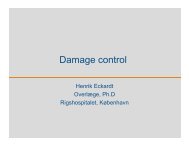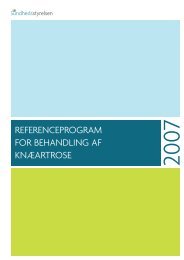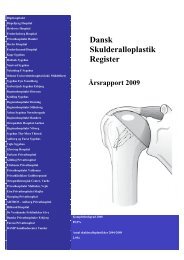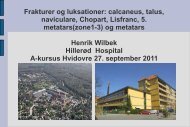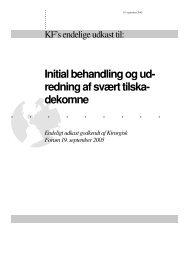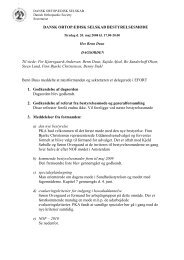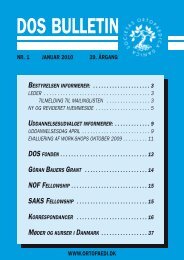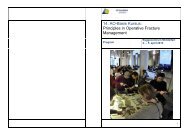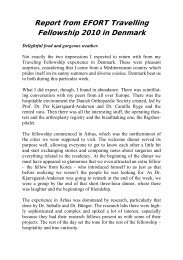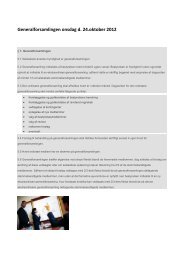DOS BULLETIN - Dansk Ortopædisk Selskab
DOS BULLETIN - Dansk Ortopædisk Selskab
DOS BULLETIN - Dansk Ortopædisk Selskab
Create successful ePaper yourself
Turn your PDF publications into a flip-book with our unique Google optimized e-Paper software.
2010-378_<strong>DOS</strong> nr. 3 2010 29/09/10 10:08 Side 78<br />
In-vivo temperature profile at cement-bone interface<br />
during cementation of preheated femoral component<br />
Juozas Petruskevicius, Mogens Berg Laursen,<br />
Mogens Brouw Jørgensen, Kjeld Søballe, Poul Torben Nielsen<br />
Orthopedic Division, Northern Denmark Region, Aalborg Hospital,<br />
University of Aarhus; Department of Orthopaedics,<br />
University Hospital of Aarhus<br />
Background: The heat generation during cement polymerization might<br />
have a negative effect on bone tissue. Developing new methods of<br />
cementation technique such as preheating of femoral stem has renewed<br />
the discussion of whether the cement curing temperature could induce<br />
thermal osteonecrosis at cement-bone interface (CBI). Conventionally, a<br />
cold femoral stem acts as the heat sinker, while the preheating of the<br />
prosthesis above room temperature could increase the heat generation<br />
and damage the bone cells.<br />
Purpose: The aim of this study was to record a temperature profile at<br />
CBI, when cementing preheated (40° C) and non- preheated femoral<br />
components during total hip arthroplasty (THA).<br />
Methods: Eighty patients were randomly allocated to one of the 2<br />
groups with 40 in each. Peroperative temperature measurements at CBI<br />
were performed using sterile copper-constantan thermocouples at posterior<br />
femur at the level of lesser trochanter.<br />
Findings: A mean peak temperature reached 53.8 and 56.4° C (p = 0.32)<br />
when cementing non-preheated and preheated stems, respectively. However,<br />
a time interval from cement mixing to peak temperature and correspondingly<br />
cement polymerization time was significantly shorter (40<br />
sec, p = 0.0003) in the preheated stem group. The median exposure time<br />
with temperatures above 50° C at CBI was 70 sec. in both groups (range:<br />
0-200 and 0-190 for preheated stem and control group, respectively).<br />
Conclusion: High cement curing temperatures at CBI in both groups<br />
could indicate a large cement mass due to a good cement penetration at<br />
the site of the temperature recordings. Preheating of stem to 40° C had a<br />
little effect on heat generation at CBI, but had significantly reduced<br />
cement polymerization which could be beneficial to shortening the operating<br />
time.<br />
78



